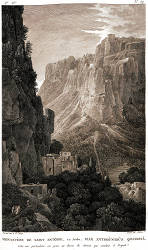دير القديس أنتوني قزحيا
Mar Antonios Kozhaya - Mar Antonios Qozhaya Monastery - Monastery of St. Anthony Qozhaya
Useful Information

| Location: | Kadisha Valley, Lebanon |
| Open: |
All year daily. [2020] |
| Fee: |
free, donations welcome. [2020] |
| Classification: |
 Cave Church Cave Church
|
| Light: |
 Electric Light Electric Light
|
| Dimension: | |
| Guided tours: | |
| Photography: | allowed |
| Accessibility: | |
| Bibliography: | |
| Address: |
Monastery of Saint Anthony - Qozhaya, Valley of Qadisha, Mail Serhel (Zgharta), Tel: +961-6-995-504, Tel: +961-6-995-505.
E-mail: Guest house, Tel: +961-6-995-507, Tel: +961-6-995-508. E-mail: |
| As far as we know this information was accurate when it was published (see years in brackets), but may have changed since then. Please check rates and details directly with the companies in question if you need more recent info. |
|
History
| 4th | according to legend founded. |
| 11th century | monastery built. |
| 16th century | monastery destroyed and quickly restored. |
| 1585 | first printing press in the Middle East set up. |
| 1708 | monastery handed down to the newly formed Lebanese Maronite Order. |
| 19th century | more than 300 monks. |
| 1998 | inscribed on the UNESCO World Heritage List. |
Description

Dayr alqidiys ’antuni qazahiaan (Monastery of St. Anthony Qozhaya) is one of the largest monasteries in the Kadisha Valley, which is also called Holy Valley, because of its numerous monasteries and churches. The monastery was erected in the 11th and 12th centuries. According to legend it was founded in the 4th century by St Hilarion, in honour of the Egyptian anchorite, St Anthony the Great. The first records date back to the 11th century, so that’s the official begin of the monastery. The monastery was destroyed in the 16th century but immediately restored.
The impressive church was built inside a natural cave in an overhanging cliff, and partly carved into the rock. The facade was built by joining the pink stones with lead instead of mortar. A series of arches in the upper part is supported by twelve pink pillars resting on copper sills. Three bell towers on the top are quite special: the one in the middle was constructed from a single piece of rock. Most of the monastery was built directly in front of the cliff but a number of hermitages were cut into the rock.
The monastery is quite famous, as the first printing press in the Middle East was set up here in 1585. It can be visited in the museum of the monastery. The printing press used the Syriac alphabet.
Close to the monastery there is a sanctuary known as Cave of Qozhaya or as Cave of the Lunatics because lunatics and possessed people used to be chained there. It is supposed to extend to Eden, that’s why it is a popular place for miracles, especially for miracle healings of those who are mentally ill. It is famous throughout the Middle East for the miraculous cures which have taken place here.
And finally there is the Cave of Youssef Bey Karam in a high slope northwest of the Monastery. It was named after a 19th century Lebanese freedom fighter, who found refuge there during the insurrection he led against Moutassarref Daoud Pasha.
- See also
 Subterranean World Heritage List
Subterranean World Heritage List Search DuckDuckGo for "Mar Antonios Kozhaya"
Search DuckDuckGo for "Mar Antonios Kozhaya" Google Earth Placemark
Google Earth Placemark Monastery of Qozhaya - Wikipedia (visited: 06-JUL-2020)
Monastery of Qozhaya - Wikipedia (visited: 06-JUL-2020) Qozhaya - the Monastery of St. Anthony, official website (visited: 06-JUL-2020)
Qozhaya - the Monastery of St. Anthony, official website (visited: 06-JUL-2020) Mar Antonios Qozhaya Monastery (North Lebanon) (visited: 06-JUL-2020)
Mar Antonios Qozhaya Monastery (North Lebanon) (visited: 06-JUL-2020)
 Index
Index Topics
Topics Hierarchical
Hierarchical Countries
Countries Maps
Maps